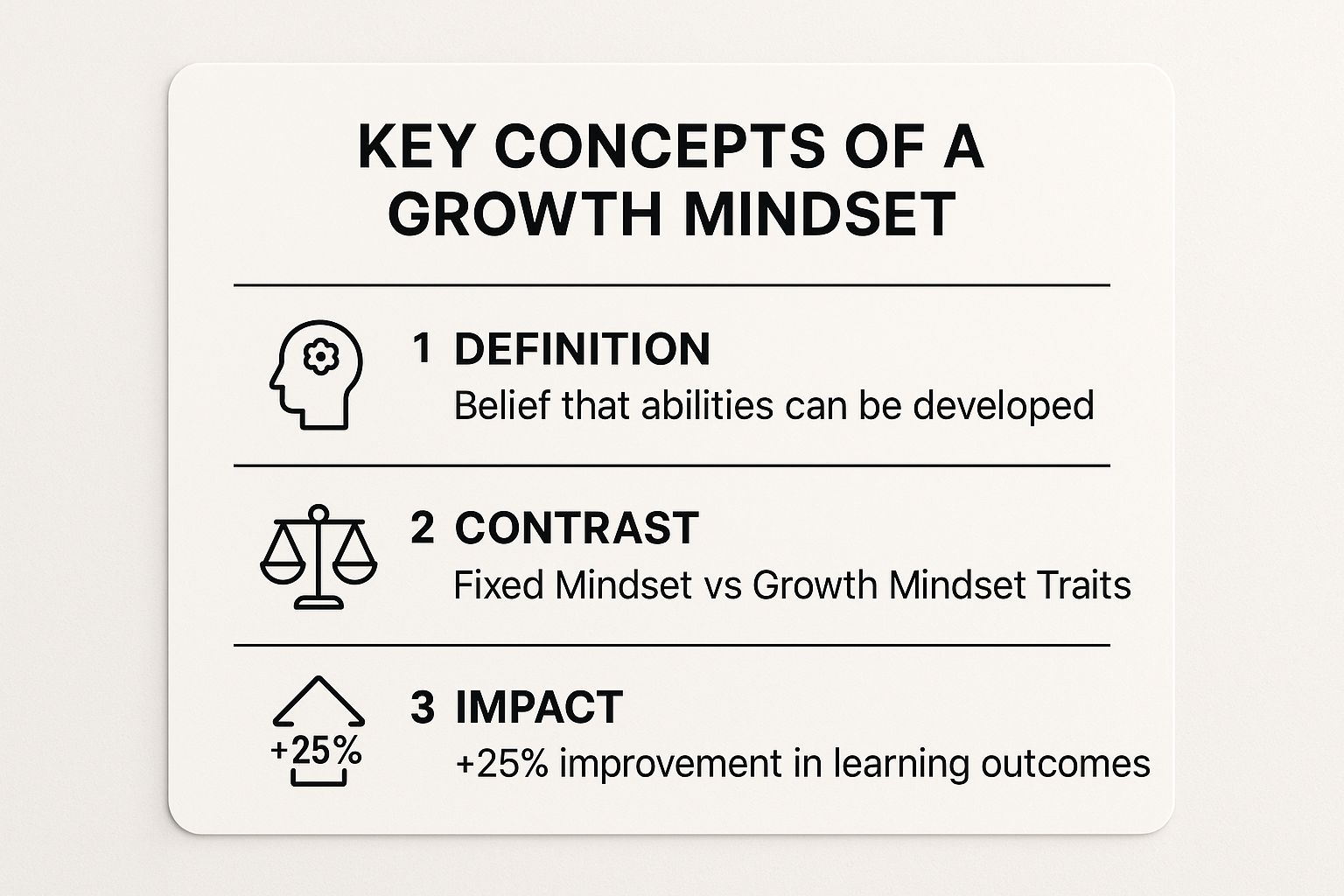A Founder's Practical Guide to Developing a Growth Mindset
Discover how to develop a growth mindset to navigate the founder's journey. Learn practical, actionable strategies for building resilience and driving success.
To develop a growth mindset, you need to fundamentally rewire how you view your abilities. It's the critical shift from believing your talents are fixed traits to knowing they are skills you can build through deliberate effort and learning.
It's the simple but powerful switch from, "I'm not good at this," to a more strategic, "I can learn how to get good at this."
The Founder's Advantage: Why a Growth Mindset is Non-Negotiable
For anyone building a company from the ground up, this mental operating system isn't just a nice-to-have. It's a core tool for survival and growth.
The startup journey is a relentless series of challenges. You'll face painful product demos, get blindsided by a competitor's funding announcement, and navigate constant uncertainty. A fixed mindset interprets these events as fatal roadblocks—proof that you're not cut out for this.
A growth mindset, however, insists that every challenge is data. Each setback, every piece of brutally honest feedback, becomes an essential clue for your next move. This is the engine that powers resilience, turning inevitable failures into your single biggest competitive advantage.
Understanding the Core Difference: Prove vs. Improve
This mental shift completely redefines your relationship with effort and feedback. Instead of avoiding hard tasks to protect your ego, you start actively seeking them out. You see them as opportunities to expand your capabilities. The focus moves from proving how smart you are to improving how smart you are.
Adopting a growth mindset fundamentally changes how you process information. It transforms obstacles from threats into opportunities for learning, which is the single most important activity for an early-stage founder.
This is why many successful founders adopt a problem-first mindset. It's a direct application of this principle, framing every market challenge not as an impossible barrier but as a valuable opportunity waiting for the right solution.
This infographic effectively breaks down the core concepts, placing the two mindsets side-by-side to illustrate their real-world impact.

The science is clear: believing your abilities can be developed directly correlates with better learning outcomes. For a founder, learning faster than the competition isn't just an edge—it's everything.
To see how this plays out, let's look at common founder scenarios. Notice how the same challenge can lead to two drastically different outcomes, all based on the founder's internal monologue.
Fixed vs. Growth Mindset Scenarios for Founders
| Founder Challenge | Fixed Mindset Reaction | Growth Mindset Response |
|---|---|---|
| A major feature launch flops | "I'm a failure. Our product is terrible. Maybe I'm not cut out for this." | "Okay, that didn't work. What can we learn from the user feedback? Which assumptions were wrong?" |
| A competitor raises a huge round | "They're going to crush us. We can't compete with that much money." | "Interesting. This validates the market. Let's focus on our niche and out-execute them where it matters." |
| Receiving harsh user feedback | "This user doesn't get what we're building. They're not our target audience." | "This feedback is a gift. What is the underlying problem this person is trying to solve for?" |
| Struggling to learn a new skill (e.g., fundraising) | "I'm just not good at pitching. I'm too technical/not a salesperson." | "Pitching is a learnable skill. Who can I learn from? What books can I read? I'll practice until I improve." |
| A key employee resigns unexpectedly | "This is a disaster. We're totally screwed without them. Everyone will probably leave." | "This is a setback, but it's an opportunity to rethink the role. What skills do we really need for our next phase?" |
As you can see, the event itself is neutral. It's the founder's interpretation—their mindset—that dictates whether it becomes a tombstone or a stepping stone. A fixed mindset leads to defensiveness and stagnation, while a growth mindset sparks curiosity, learning, and relentless forward motion.
Your internal dialogue is your most influential advisor. It can either fuel your ambition or sign off on your defeat. To develop a growth mindset, you must become the active manager of this internal conversation, turning it from a harsh critic into a strategic coach.

This process starts with a simple, honest audit. For one week, pay sharp attention to your automatic thoughts during moments of stress or perceived failure. What’s your gut reaction when a product demo flops, a key hire says no, or a competitor lands a massive funding round? These are the moments your default mindset roars to the surface.
Spotting Fixed-Mindset Traps
The most destructive thoughts are usually absolute and deeply personal. They sound less like an assessment of a specific situation and more like a final judgment on your core abilities.
Watch out for these classic fixed-mindset triggers:
- "I messed that up." This is a statement of identity, not action. It implies the mistake is a permanent, unchangeable part of who you are.
- "I can't believe they got that funding." This obsesses over an external event you can't control, breeding helplessness and envy.
- "They just don't get my vision." This is blame-shifting. It stops you from digging for the valuable feedback almost always hidden in someone's confusion or criticism.
These thoughts are strategic dead ends. They shut down problem-solving and lock you into a defensive crouch. The goal isn't to pretend you don't feel the sting of frustration, but to consciously intercept these thoughts before they take root and dictate your next move.
The "What If... Then..." Reframe
Once you've caught a destructive thought, you need a practical tool to flip it. The "What If... Then..." framework is a powerful method for turning a self-critical dead end into a forward-looking action plan. It's a simple, three-part mental conversion.
Let's walk through a common founder scenario: a sales call that goes nowhere.
| Original Thought (Fixed Mindset) | "What If" Question (Curiosity) | "Then" Statement (Action) |
|---|---|---|
| "I'm terrible at sales. I completely botched that pitch." | "What if my value proposition wasn't clear enough for their specific pain points?" | "Then I will refine my slides to address those points directly before the next call." |
| "This is too hard. I'll never close a deal this big." | "What if I asked a mentor for a brutally honest take on my approach?" | "Then I can incorporate their advice and try a different strategy next time." |
| "They were never going to buy. That was a total waste of time." | "What if I review the call recording to find the exact moment their engagement dropped?" | "Then I can pinpoint the weak spot in my pitch and strengthen it." |
Notice this isn't about forced positivity. It’s a strategic pivot from emotional reaction to logical analysis. You're redirecting mental energy from self-criticism to problem-solving.
This mental reframing is a core discipline. For more on building this kind of resilience, our guide on how to improve self-discipline offers complementary strategies that reinforce this practice.
By intentionally reframing your inner monologue, you transform setbacks from verdicts on your ability into valuable, actionable intelligence. It’s the difference between "I failed" and "That approach failed."
This small but critical linguistic shift is the heart of building a resilient, growth-oriented mind. It turns your self-talk into your most effective coaching session, fueling real, continuous progress.
Turn Setbacks into Strategic Data
For a founder, failure isn't just an obstacle—it's expensive data. If you're paying that much for it, you better learn how to use it.
To develop a growth mindset, you must learn to squeeze every drop of strategic value from moments that go wrong. This isn't about "coping" with setbacks; it's about weaponizing them. A botched product launch or a missed quarterly target isn't a final verdict. It’s raw intelligence about your customers, your market, and your own internal blind spots.
The game changes when you shift from blame to analysis. A fixed mindset asks, "Whose fault was this?" A growth mindset asks much better, more profitable questions:
- "Which of our core assumptions was proven wrong?"
- "What is this painful data telling us about our customers' real needs?"
- "How do we change our process so we don't make this specific mistake again?"

This systematic approach to dissecting mistakes builds a resilient, high-performing culture. When your team sees that failure leads to insight, not punishment, they become more willing to take the calculated risks that lead to breakthroughs.
Run a Blameless Post-Mortem
One of the most powerful tools for this is the blameless post-mortem. After any significant setback, gather the team—not to point fingers, but to deconstruct the process. The focus must remain on systems, not people.
Imagine your team ships a new feature, and user engagement is zero.
- A blame-focused meeting tries to identify the engineer who wrote buggy code or the marketer whose campaign fell flat. This creates fear and defensiveness.
- A blameless post-mortem investigates the entire chain of events. Did we validate the customer problem before building? Was our user testing process flawed? Did our marketing message align with what the feature actually did?
This simple shift reframes the event from a personal failure to a systemic learning opportunity. In SprintDojo, you can integrate this into your process by documenting these insights in your weekly review, creating a timeline of lessons learned. Over time, the platform’s AI can even spot recurring process gaps you might otherwise miss.
A blameless post-mortem transforms the painful question of "Why did we fail?" into the productive question, "What did we learn, and how do we improve?" It's the operational engine of a growth mindset.
Pivot from Failure to Success
Startup history is filled with famous companies that used early "failures" to pivot into massive success. Slack, for example, started as a gaming company called Glitch. When the game failed, the founders didn't just give up. They analyzed what did work: the internal communication tool they'd built for themselves to collaborate.
That "failed" game provided the data for a multi-billion-dollar pivot.
This ability to spot potential in the wreckage is directly tied to the core belief that you can improve. A global meta-analysis published in Nature found a strong link between a growth mindset and academic achievement in 72 out of 74 nations. This demonstrates that believing you can get smarter is a near-universal lever for achieving better results. You can explore the full analysis to see how powerful this concept is across different cultures.
Seeking Challenges and Processing Feedback
A fixed mindset avoids challenges as an ego-protection mechanism. To develop a genuine growth mindset, you must do the opposite: sprint toward them. That’s where real growth happens.
For a founder, this means intentionally seeking a state of productive discomfort.
This isn't about being reckless. It's about systematically pushing your boundaries with "stretch goals" that pull you just beyond your current abilities but don't break your spirit. This proactive pursuit of difficulty is what separates stagnant businesses from those that evolve rapidly.

Even more important is mastering the art of actively soliciting and digesting tough feedback. This creates a powerful, high-velocity loop that accelerates both your personal capabilities and your company’s trajectory.
Actively Hunt for Tough Feedback
A fixed mindset waits for feedback, then gets defensive. A growth mindset hunts it down, especially the uncomfortable kind. Instead of fishing for praise, dig for critique.
After a customer demo, most people ask, "What did you think?" This question invites polite, useless answers.
Instead, ask targeted, open-ended questions designed to uncover the truth:
- "What was the most confusing part of that for you?"
- "If you had a magic wand, what's the one thing you'd change about what you just saw?"
- "Be brutally honest—was there any point where you thought, 'I would never use this'?"
This line of questioning signals that you value learning over ego, giving the other person permission to be truly helpful instead of just nice. This same principle applies to learning new skills. Pushing your limits through experiences like structured 'Atomic Challenges' can hardwire this part of your mindset.
Filter Input for Actionable Truth
Not all feedback is created equal. Once you've collected raw, honest input, your next job is to process it without emotion. You must filter the signal from the noise.
Think of yourself as a detective, not a defendant. Every piece of criticism is a clue pointing toward an underlying problem or an unmet need.
The real skill isn't just hearing criticism; it's detaching your ego from the feedback to find the objective truth hidden within. That truth is the rocket fuel for your next iteration.
For instance, if an early customer says, "Your pricing is way too high," the fixed mindset reaction is to get defensive or immediately slash prices. The growth mindset response is to ask why. Is it because the value wasn't communicated clearly? Or is the product genuinely missing a key feature that would justify the cost?
This process of constantly seeking challenges can be draining. Building a system for staying motivated when things get tough is crucial to ensure you don't burn out.
In SprintDojo, you can use the weekly review to document all this feedback from mentors and customers. The Sensei AI then helps you spot patterns over time, identifying recurring themes that point to core strategic issues, turning scattered feedback into a clear, actionable plan.
Building a Growth Mindset into Daily Habits
A growth mindset isn't a motivational poster. It’s a set of real, daily, repeatable actions. To truly develop one, you have to wire it into your operational DNA. This means turning abstract ideas into concrete, automatic practices.
The goal is to build a system of small rituals that reinforce learning, celebrate effort, and build resilience. When these practices become second nature, you create a sustainable engine for your own growth and your company's innovation.
End Your Day with a Learning Debrief
Carve out just five minutes at the end of each day for a simple ritual. Instead of reviewing what you did, shift your focus to what you learned. It’s a small change in perspective with a powerful impact.
Just ask yourself two questions:
- What was my single biggest challenge today?
- What did I learn from how I handled it?
This isn’t a performance review; it's a learning inventory. Maybe you discovered a new keyboard shortcut that saved you ten minutes. Or maybe you learned your pitch completely bombs if you don’t lead with a specific customer pain point. Both are valuable data points.
Writing these insights down, even in a simple note, builds a personal repository of wisdom. It trains your brain to see every day as a series of learning opportunities, not just a checklist of tasks. This habit is fundamental to making real progress. You can find more strategies like this in our guide on how to build good habits that last.
The power of a growth mindset isn't just believing you can grow; it's creating the daily feedback loops that prove it to yourself.
Block Off Time for Deliberate Learning
As a founder, you're constantly putting out fires. It’s easy to fall into the trap of only learning what you need for the immediate crisis. A true growth mindset demands proactive, not just reactive, learning.
Get your calendar out and physically block off time for deliberate learning. This could be 30 minutes, twice a week, dedicated to a skill outside your immediate to-do list—like learning a new data analysis tool or reading about behavioral psychology.
This practice is a secret weapon for creativity, helping you connect seemingly unrelated dots. It also reinforces the core idea that your skillset is something you actively build, not something you were born with.
Celebrate the Process, Not Just the Win
The way you talk about progress with your team directly shapes your company's culture. If you only celebrate big wins and successful outcomes, you inadvertently create a fear of failure. People will become scared to try ambitious things where the result isn't guaranteed.
Instead, make a conscious effort to praise the process:
- "I was really impressed with the strategy you used to tackle that bug." (This praises the approach.)
- "The effort your team put into that launch, despite the setbacks, was incredible." (This praises resilience.)
- "The questions you asked in that client meeting showed you were digging for the real problem." (This praises curiosity.)
This simple shift encourages experimentation and validates hard work. It sends a clear message that learning and effort are what you value most. A landmark 2018 OECD PISA study found that nearly two-thirds of students showed a growth mindset, which strongly correlated with higher academic scores and a greater sense of belonging at school. This proves that fostering a belief in development yields tangible results.
FAQ: The Gritty Realities of a Growth Mindset
Embracing a growth mindset sounds great in theory. But when you’re staring down a dwindling bank account or getting your 10th "no" of the week, those optimistic blog posts can feel a world away. It’s one thing to know you should learn from failure; it’s another to do it when your stomach is in knots.
Let's cut through the platitudes and tackle the real, gritty questions that come up in the trenches of building a company.
How do I not take rejection personally?
It’s brutal. Hearing "no" from investors, customers, or potential hires feels like a personal attack. The instinct is to internalize it, to let it chip away at your confidence until you start questioning everything.
The only way out is to re-engineer your goal. Stop trying to get a "yes." Start trying to collect data.
This isn't just a semantic trick; it's a fundamental shift in perspective. Each rejection becomes a data point. Instead of feeling the sting of failure, you force yourself to become an analyst.
- "Where did their eyes glaze over in my pitch?"
- "What pattern am I hearing in these objections?"
- "What does this specific 'no' tell me about my product's positioning?"
This pivot from emotional reaction to strategic analysis is your lifeline. It turns rejection from a roadblock into a compass, recalibrating your approach with every interaction. Suddenly, each "no" isn't a dead end—it's a step closer to the right "yes."
Isn't this just toxic positivity?
No. And this distinction is mission-critical. Ignoring reality is a death sentence for a startup.
Toxic positivity is denial. It’s putting on a happy face and saying, "Everything is fine!" when your burn rate is out of control. It’s a refusal to engage with the problem.
A growth mindset is confrontation. It’s looking a brutal reality straight in the eye and asking, "What can I learn from this? What can I do about it?"
Toxic positivity is ignoring the fire. A growth mindset is grabbing the fire extinguisher and believing you can figure out how to use it. One leads to delusion and ruin; the other leads to resilience and progress.
It’s the raw honesty to admit, "This is really hard, and I'm stressed," immediately followed by the action-oriented question: "Okay, so what's the next move?" It’s pragmatic optimism, not blind faith.
How do I get my team on board?
Your team takes its cues from you. They will mirror your behavior, not just your words. If you want a team with a growth mindset, you have to model it relentlessly.
First, get comfortable being publicly wrong. When you make a mistake, talk about it. Explain what happened, what you learned, and how you’ll approach it differently next time. This makes it psychologically safe for others to do the same. It frames errors as a source of learning, not shame.
Second, be intentional about praise. Most leaders default to praising talent ("You're a rockstar!"). This is a fixed-mindset trap that implies ability is innate.
Instead, praise the process, the effort, and the strategy.
- Instead of: "You're so smart."
- Try: "I was really impressed with how you broke that problem down into smaller pieces."
This small linguistic shift has a huge impact. It reinforces the idea that success comes from things people can control—their strategies, their work ethic, their willingness to learn. You're not just building a team; you're building a collective belief that you can all get better, together.
Ready to turn these ideas into ingrained habits? SprintDojo is a productivity system built for founders, using behavioral science and AI to help you track progress, stay accountable, and build the discipline of continuous improvement.
Start building your operating system for success at sprintdojo.com.
Sprint Smarter. Forecast Every Week.
Log wins. Build momentum. Let AI show you if you're on track to hit your sprint goal—before it's too late.
Join the waitlist and be the first to unlock predictive clarity for your team.